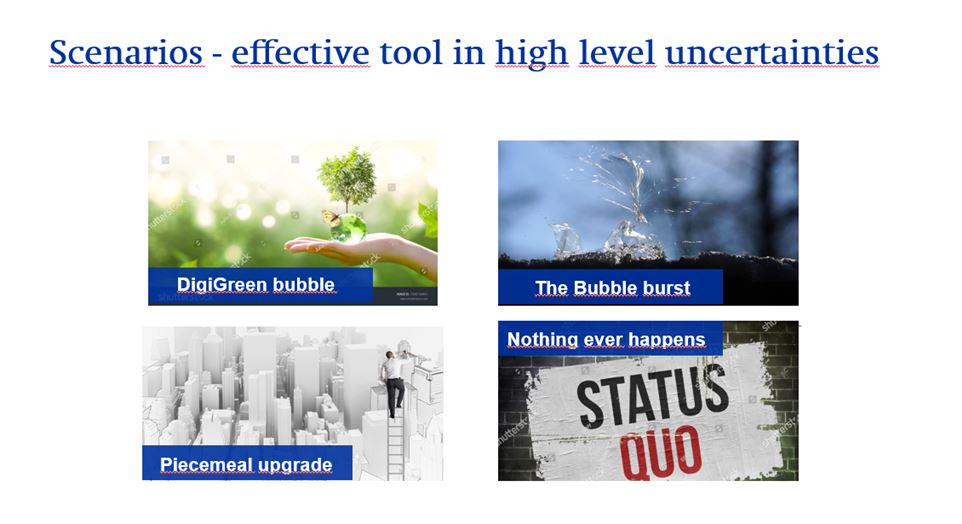A comparative review of socio-economic implications of the coronavirus pandemic (COVID-19) in the Baltic States
A comparative review of socio-economic implications of the coronavirus pandemic (COVID-19) in the Baltic States was joint effort of Foresight Centre of Parliament of Estonian, LV PEAK of the University of Latvia and Government Strategic Analysis Center (STRATA) of Lithuania.
Review presents possible coordinated policy actions through scenario building that could support speedier recovery, long term technological progress and sustainable growth.

DigiGreen bubble
In 2030, the Baltic states become the “centre of excellence” for the rest of EU in areas of digital and green transformation by incorporating newest IT, development of biotechnologies and applying them widely without borders in all major policy areas, by attracting EU funds, exploring opportunities of expanding collaboration between the Baltic and leading Nordic, UK and ohter countries research and industry. The three Governments have made a joint proposal to EC to become a “testbed”/ sandbox for development of new digital
and biotechnologies and testing them in practice. Experimental laws enabling testing were passed in the three states, e-residence model was expanded to all the Baltic states, thus allowing to establish business, live and get educated anywhere, as a result, investments flood and the Baltic states get a quick uplift in living standards, income to Treasuries, positive image for the states, etc. All three Baltic states become the most popular holiday travel destination as it is safe and clean here (health conditions can be tested and verified easily), and due to climate change the north becomes “new south”.
The Bubble burst
As EU has managed quickly to provide a new anti-COVID vaccine for its member states, since 2021 the three Baltic states each further built on their own alternative ideas and current strengths: further advancement e-Stonia lead to the expanded digital nation (biggest among the three); development of life sciences in Lithuania lead to development of “Green Lithuania”, Latvia – becoming the gateway for the “Baltic bubble” to Europe, etc. The three countries are finally connected by Rail Baltica, thus, advantages of each country can be partly extended and shared to the other countries (some bits of e-residence programme available for Latvia and Lithuania, every third flight of Air Baltic is operated from Vilnius and Tallinn, respectively, etc.).
Piecemeal Upgrade
By 2030, each of the three Baltic states have developed bits of digital and green transformations after negotiations for EU Recovery and Resilience Facility. The Brussels provided the “Baltic bubble” as an outstanding example of trilateral cooperation and advised the three governments to bring more of joint proposals (for the reasons of diminishing administrative burden for national as well as EU agencies, inter alia), especially as development of modern technologies allow them to be better connected. As a result, projects of digital and green transformations are implemented by means of trilateral consortiums where research institutions, business, and governmental agencies from three countries are involved. However, due to some inner considerations prevailing (“who gets what?”) and other obstacles to cooperation, the real progress in implementation of big projects remains negligent.
Nothing ever happens
The Baltic Assembly in 2030 meets virtually (by means of augmented reality) to discuss potential areas of further Baltic States cooperation.
Possible coordinated actions of the three Baltic States to build back better
The Baltic states, because of common past, similar level of economic development as well as similar foreign and economic policy orientation, have good chance to become the world’s most integrated region.
Today the geopolitical and economic realities are such, that distortion of global supply chains open-up opportunities for attracting more industrial investments to Europe. It presents a unique opportunity for the Baltic states. As size matters, by acting alone the Baltic states will achieve little. In order to win place among the most developed nations of the world, our markets need to be more integrated. Ideally, there should be no difference between the three Baltic markets from the perspective of labor and companies. A registration in one country should be sufficient for activity in all three markets, including access to banking services. Likewise, the supervision of market participants in the future should be carried out jointly not separately.
In order to move towards closer mutual integration, a fresh impetus must be given to the Baltic Council of Ministers. Like within the Nordic Council of Ministers, each government would need to appoint a minister responsible for cooperation with the other Baltic states. More regular meetings among all governmental ministers is also required. The work of ministers should be aided by joint working groups on different subject matters.
In a longer perspective the Recovery and Resilience Facility, aimed at making the EU economies more sustainable, resilient and better prepared for the challenges posed by the green and digital transitions creates a common ground for fostering transformation of the whole Baltic region. Practical examples of joint actions could include creation on common e-residency programme, joint green energy initiatives (e.g. windfarm in Baltic Sea) or perhaps creation of joint VR tourism programs.
Authors: Foresight Centre of Parliament of Estonian, LV PEAK of the University of Latvia and Government Strategic Analysis Center (STRATA) of Lithuania.

 An independent think tank at the Riigikogu
An independent think tank at the Riigikogu